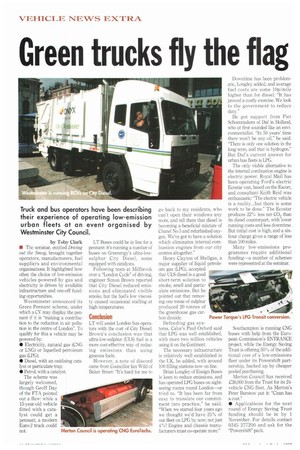Green trucks fly the flag
Page 18

If you've noticed an error in this article please click here to report it so we can fix it.
Truck and bus operators have been describing their experience of operating low-emission urban fleets at an event organised by Westminster City Council.
by Toby Clark III The seminar, entitled Driving out the Smog, brought together operators, manufacturers, fuel suppliers and environmental organisations. It highlighted how often the choice of low-emission vehicles powered by gas and electricity is driven by available infrastructure and one-off funding opportunities.
Westminster announced its Green Pennant scheme, under which a CV may display the pennant if it is "making a contribution to the reduction in air pollution in the centre of London". To qualify for this a vehicle may be powered by: • Electricity, natural gas (CNG or LNG) or liquefied petroleum gas (LPG); • Diesel, with an oxidising catalyst or particulate trap; • Petrol, with a catalyst.
The scheme was largely welcomed, though Geoff Day of the FTA pointed out a flaw: while a 15iear-old vehicle fitted with a catalyst could get a pennant, a modern Euro-2 truck could not. LT Buses could be in line for a pennant: it's running a number of buses on Greenergy's ultra-lowsulphur City Diesel, some equipped with catalysts.
Following tests at Millbrook over a "London Cycle" of driving, engineer Simon Brown reported that City Diesel reduced emissions and eliminated visible smoke, but the fuel's low viscosity caused occasional stalling at high temperatures.
Conclusion
LT will assist London bus operators with the cost of City Diesel; Brown's conclusion was that ultra-low-sulphur (LTI-S) fuel is a more cost-effective way of reducing emissions than using gaseous fuels.
However, a note of discord came from Councillor [an Wild of Baker Street: It's hard for me to
go back to my residents, who can't open their windows any more, and tell them that diesel is becoming a beneficial mixture of Chanel No 5 and refurbished oxygen. We've got to have a solution which eliminates internal-combustion engines from our city centres altogether."
Henry Clayton of Shellgas, major supplier of liquid petroleum gas (LPG), accepted that ULS diesel is a good short-term solution to smoke, smell and particulate emissions. But he pointed out that removing one tonne of sulphur produced 20 tonnes of the greenhouse gas carbon dioxide.
Defending gas systems, Calor's Paul Oxford said that LPG was well established, with more two million vehicles using it on the Continent.
The necessary infrastructure is relatively well established in the UK, he added, with around 100 filling stations now on line.
Brian Langley of Ensign Buses is keen to reduce emissions, and has operated LPG buses on sightseeing routes round London—or tried to. It has been far from easy to translate our commitment into practice,' he said. "When we started four years ago we thought we'd have 25% of our fleet on LPG by now; not just 4%! Engine and chassis manufacturers must co-operate more." Downtime has been problematic, Longley added, and average fuel costs are some 10p/mile higher than for diesel: "It has proved a costly exercise. We look to the government to reduce duty."
He got support from Piet Schoenmakers of Daf in Holland, who at first sounded like an environmentalist. "In 50 years' time there won't be any oil," he said. "There is only one solution in the long term, and that is hydrogen" But Daf's current answer for urban bus fleets is LPG.
The only viable alternative to the internal combustion engine is electric power. Royal Mail has been operating Ford's electric Ecostar van, based on the Escort, and consultant Keith Reid was enthusiastic: "The electric vehicle is a reality.. .but there is some work to be done." The Ecostar produces 22% less net CO2 than its diesel counterpart, with lower running costs and less downtime. But initial cost is high, and a six. hour charge gives a range of less than 100 miles.
Many low-emissions programmes require additional funding—a number of schemes were represented at the seminar.
Southampton is running CNG buses with help from the European Commission's ENTRANCE project, while the Energy Saving Trust is offering 50% of the additional cost of a low-emissions fleet under its Powershift partnership, backed up by cheaper pooled purchasing.
Merton Council has received £38,000 from the Trust for its 24vehicle CNG fleet. As Merton's Peter Burstovv put it: "Clean has a cost."
• Applications for the next round of Energy Saving Trust funding should be in by 1 November. For details contact 0345 277200 and ask for the "Powershift" pack.
















































































































